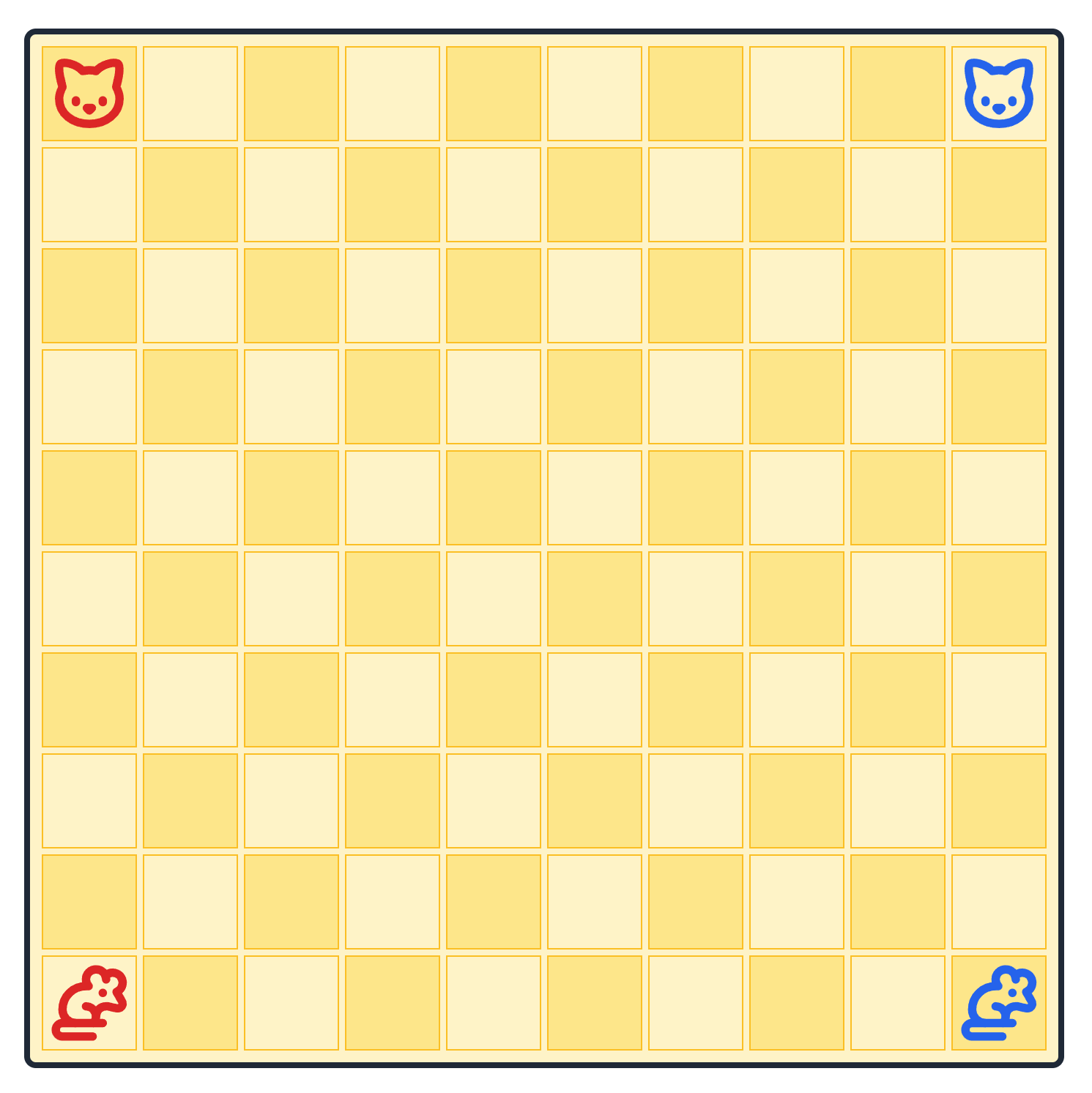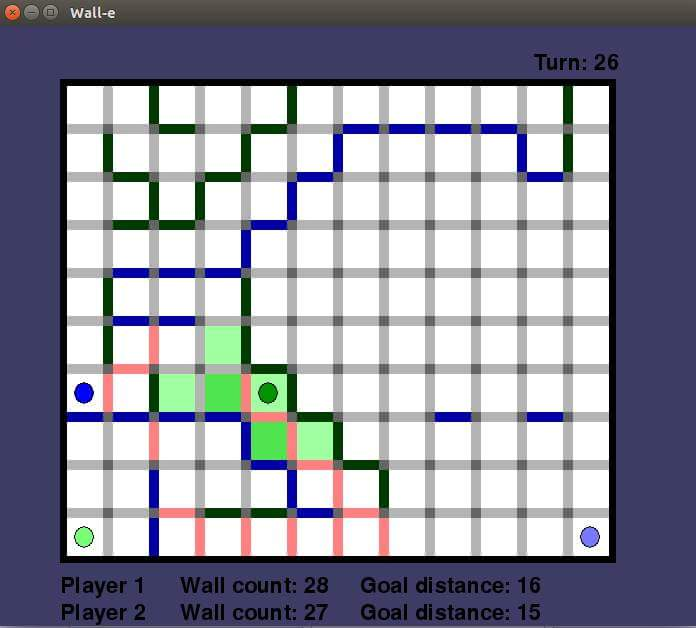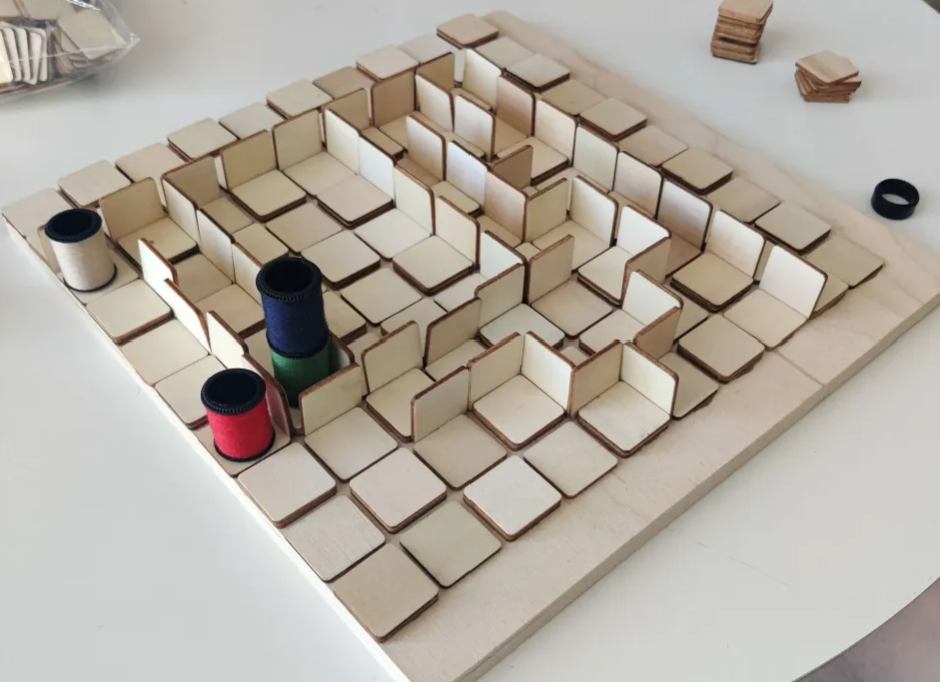The Wall Game Project

Welcome to the Wall Game project! The Wall Game is a multiplayer board game I invented, and which I'm building in public in 2025.
In this post, I'll go over how to play, my approach to building in public, and the backstory of the game. Once finished, it will be available at wallgame.io.
First of all, because I think it's a great game. I've shown it to many people over the years, and the reaction is always that (1) it's fun; and (2) it's super easy to pick up (it passes the subway-legibility test).
On a more personal note, my goal for 2025 is to get better at building things, and I believe that working on things you find fun is key for consistency.
Rules of the game
The Wall Game is simple to understand.
Initial setup: In the "standard" 2-player version of the Wall Game, the board setup looks like this:

Goal: The red player controls the red cat and mouse, and the blue player controls the blue cat and mouse. The red player wins by having their cat catch the blue mouse before the blue cat catches the red mouse.
How to move: the game is turn-based. On each turn, you can make 2 actions. Each action can be either moving your cat, moving your mouse, or placing a wall. Cats and mice move to adjacent cells, but walls can be placed anywhere between two cells on the board. The only restriction is that you cannot completely block the opponent's cat from reaching your mouse.

That's it! That's all the rules. It's simple enough that you can play it with just pen and paper.
To preempt the two most common questions:
- Moving diagonally counts as 2 actions.
- You cannot move through your own walls.
Example game
Here is an example of a full game that was played on wallwars.net (the first version of the site, which I'm currently rebuilding).
Building in public
I love the concept of building in public, sharing my learnings, and getting feedback. If nothing else, writing down my thought process helps future-me reference what I learned.
So, as I build it, I'm making a series of blog posts about the game. You can find them all at nilmamano.com/blog/category/wallgame.
So far, I've written about:
- Choosing a tech stack
- Designing the UI
- Designing the DB
- The graph algorithms behind invalid move detection (Part 1, Part 2)
Next, I'll write about Deep Wallwars, an alpha-zero-like AI made by a friend, as well as other interesting aspects of the app's implementation, like automatic puzzle generation.
Ultimately, this collection of posts should provide a playbook for building any multiplayer online game, not just the Wall Game.
Backstory
The game dates back to my high school days, circa 2006, when my friends and I entertained ourselves with pen-and-paper games. Around that time, I played Quoridor once at a friend's house, and that inspired me to make a pen-and-paper game with similar ideas but with my own rules, like having two actions per move and unlimited walls. After some experimentation, we settled on a 10x12 board, with players starting at the top corners and having to move to their opposite corners (there was no "mouse" yet).
The game was a hit among my high-school friends, and I've basically been playing it and showing it to people ever since. For example, the name WallWars, which I used until the recent rebranding to the Wall Game, was coined by a PhD colleague in 2016 (let me know which name you like more).
In 2012, during college, I implemented a version of the game in Python (it's on GitHub):

However, that version was not online, so, in 2020, I reimplemented it as a full-stack app to play with my friends during the Covid-19 lockdowns. It's currently live at wallwars.net. According to the DB, 421 online games have been played as of May 2025 (I'm the most active player by far).
In 2021, I started building a C++ minimax-based engine for the game, which you can play against on wallwars.net thanks to WebAssembly. Optimizing it was a challenge, as the branching factor is much higher than, e.g., in chess. Eventually, I got it to work well for small boards, but it was still not good enough for the exponential explosion that comes from bigger boards. That's when Thorben came to the rescue with the Deep Wallwars project, an alpha-zero-like engine that scales a lot better to bigger boards. This is not integrated on the site yet, but it's planned for the rebuild.
In 2023, I built a physical board to play in person:

We started experimenting with different variants, in part to accommodate 4 players, but also because we realized that exploring variants of the rule increased the game's replayability. As long as the same strategic and tactical patterns are present, variants are really fun, like playing a new level of a video game. This is also when I adopted the "cat and mouse" variant as the default.
Two of the main reasons I want to rebuild the site are to integrate Deep Wallwars and to support variants, as each of these would require a major overhaul.